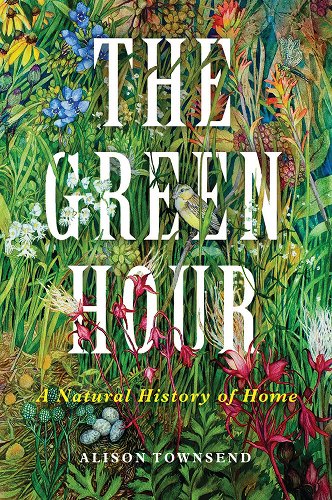Reviewed by Emily Webber
 Alison Townsend’s memoir in essays, The Green Hour: A Natural History of Home (University of Wisconsin Press, January 2022) is titled after the way the light falls in the evenings at her home in Wisconsin, and the book profoundly connects to the places Townsend calls home. The Green Hour is full of quiet and contemplative essays about Townsend’s relationship with where she lives and her family and friends. No lines are wasted, and every sentence contains wondrous details of the natural world. The ideas of home, belonging, and remembering are constant threads throughout the book, intricately linked to the land Townsend inhabits.
Alison Townsend’s memoir in essays, The Green Hour: A Natural History of Home (University of Wisconsin Press, January 2022) is titled after the way the light falls in the evenings at her home in Wisconsin, and the book profoundly connects to the places Townsend calls home. The Green Hour is full of quiet and contemplative essays about Townsend’s relationship with where she lives and her family and friends. No lines are wasted, and every sentence contains wondrous details of the natural world. The ideas of home, belonging, and remembering are constant threads throughout the book, intricately linked to the land Townsend inhabits.
“At the bottom of the hill, after making my way through a copse of saplings, their dead leaves rustling like taffeta, I clambered up behind the shelter of our oldest tree, the red oak we call Grandmother. Over ten feet in circumference, some of her roots visible above ground like higgledy-piggledy stairs gripping the hill, the Grandmother stands sentinel, guarding the hidden rear flank of the property. Once, in a difficult season, I leaned into this tree and felt her lean back, absorbing all my fear and anxiety.”
At the memoir’s start, Townsend is looking to buy her first home in Wisconsin with her husband. They have found a seemingly perfect place. They ultimately buy it, but Townsend is hesitant. She realizes later that they had been looking at the house during Advent, the same time of year her mother died of breast cancer when Townsend was 9. Townsend’s early childhood was spent in Eastern Pennsylvania at a place they called Wild Run Farm, which is the first landscape she loved. But when her mother gets sick, and they move, it becomes a loss of a safe place.
The essays in the first part of the book are saturated with loss and loneliness. Many of the essays at the beginning of the book filled me with an immense sense of loneliness, which is not meant to be negative, but it is a testament to the deeply personal writing in The Green Hour. In these first sections, Townsend’s mother haunts the pages. In “My Mother’s Dress,” Townsend’s cousin unearths a dress that Townsend’s mother wore to a wedding. It arrives just before Townsend’s wedding and fits her perfectly. With the dress comes a connection to her mother and Townsend’s attempt to learn who her mother was as a woman through the objects left behind.
Townsend revisits her mother often in this memoir, sometimes remembering, sometimes trying to recreate her, sometimes lamenting how much she can’t remember of her after so much time has passed. It is a moving portrait of the unique kind of grief that comes with losing a parent at a young age. Townsend also openly recounts her struggle with mental health and her stay in a psych ward. But at the heart of everything is her mother’s memory which is entwined throughout her whole story. Throughout The Green Hour, Townsend is mourning what she has lost and eventually reclaiming a feeling of peace. She keeps her mother close by continuing to examine her short life, speak about her, and find the same solace and connection to something beyond herself in the natural world as she did.
Townsend, the author of several poetry collections, turns a poet’s eye to her surroundings. As she gets older, she connects with other places in California and Oregon and eventually settles in Wisconsin. This book is a conversation with the places Townsend inhabits and one that fully draws the reader in with precise and detailed descriptions. Long meditative passages describing the land capture the beauty and mystery of the natural world. Each sentence contains images that bring the reader deeper and deeper into Townsend’s environment.
“The birds erupt into the air, the huff of their many wings like the hand of God passing briefly over my face.”
Townsend becomes fully present in her space in Wisconsin. She catalogs the wildlife, the water, and the trees. As the book progresses, feelings of loneliness subside, replaced with beauty and wonder. The reader can see that the sense of safety of home and the comfort of the company of those who genuinely know and love her has returned.
The Green Hour: A Natural History of Home, while all about the natural world Townsend lives on and explores, isn’t explicitly an environmental book, but her call to action is evident in her path. By settling into her home in Wisconsin, embracing and observing the world around her, she finds healing and wholeness. Deep respect and love for the natural world emerge from that place—and a desire to protect and honor the earth and herself.
 Emily Webber’s writing has appeared in The Writer magazine, the Ploughshares Blog, Five Points, Maudlin House, Brevity, and Slip Lip Magazine. She’s the author of a chapbook of flash fiction, Macerated, from Paper Nautilus Press. Find more at emilyannwebber.com and on Twitter: @emilyannwebber.
Emily Webber’s writing has appeared in The Writer magazine, the Ploughshares Blog, Five Points, Maudlin House, Brevity, and Slip Lip Magazine. She’s the author of a chapbook of flash fiction, Macerated, from Paper Nautilus Press. Find more at emilyannwebber.com and on Twitter: @emilyannwebber.


